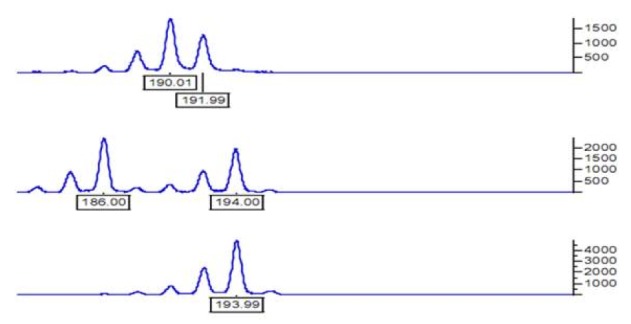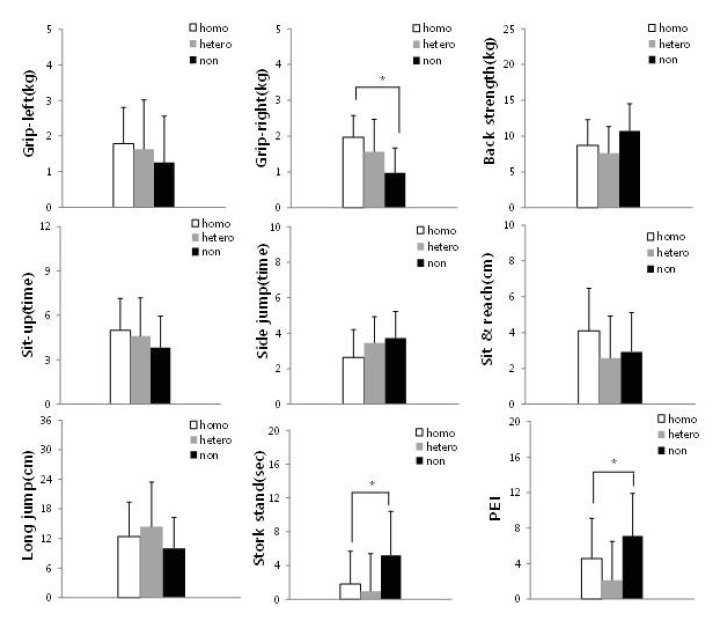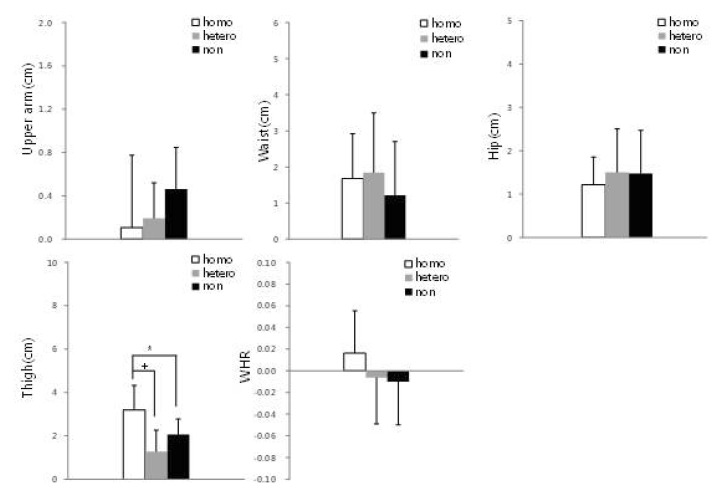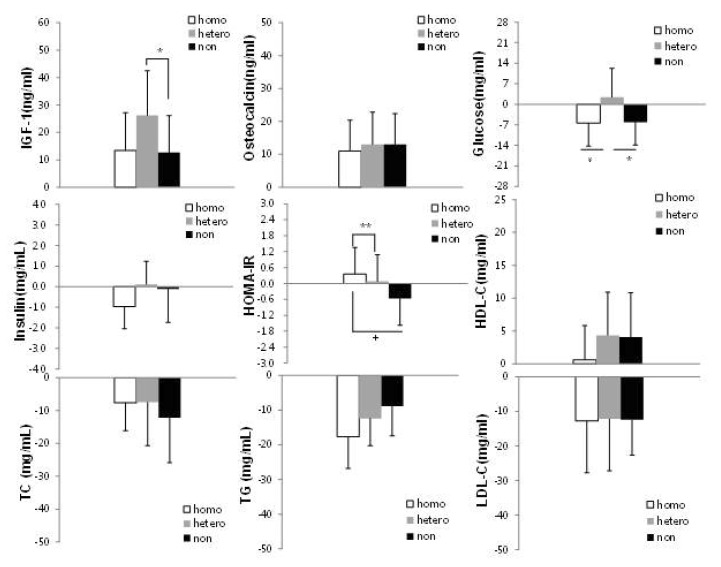Korean J Physiol Pharmacol.
2015 Jul;19(4):341-347. 10.4196/kjpp.2015.19.4.341.
Effect of Taekwondo Training on Physical Fitness and Growth Index According to IGF-1 Gene Polymorphism in Children
- Affiliations
-
- 1Department of Physical Education, Keimyung University, Daegu 704-701, Korea. kjk744@kmu.ac.kr
- KMID: 2285577
- DOI: http://doi.org/10.4196/kjpp.2015.19.4.341
Abstract
- This study analyzed the effect of regular Taekwondo training for 16 weeks on physical fitness and growth index depending on different IGF-1 gene polymorphisms. The subjects of the study were 44 male students who were 8 year years old. The IGF-1 gene showed the highest frequency of 18 CA repeat (190 bp) in 50% of subjects, and was found in the homozygote (n=11), heterozygote (n=22) and non-carriers (n=11). The results of the physical fitness and growth index among the gene polymorphism groups indicated no significant differences but the expected height of the non-carrier group was significantly high (p<0.05). After Taekwondo training, the homozygote group and the non-carrier groups demonstrated significant (p<0.05) increase in grip strength and in time in the standing with one leg while closing eyes test, respectively. Only the homozygote group had a significant (p< 0.05) increase in thigh circumference. IGF-1 concentration significantly (p<0.05) increased in the heterozygote group, while HOMA-IR significantly (p<0.05) decreased in the homozygote group. Furthermore, there was a significant (p<0.05) decrease in glucose in both the homozygote and the non-carriers groups. The difference between physical fitness and growth index depending on the IGF-1 gene polymorphism after Taekwondo training did not show consistent impact.
Keyword
MeSH Terms
Figure
Reference
-
1. WTF. World Taekwondo Federation member status. 2013. www.wtf.org.2. Daughaday WH, Rotwein P. Insulin-like growth factors I and II. Peptide, messenger ribonucleic acid and gene structures, serum, and tissue concentrations. Endocr Rev. 1989; 10:68–91. PMID: 2666112.
Article3. Florini JR, Ewton DZ, Coolican SA. Growth hormone and the insulin-like growth factor system in myogenesis. Endocr Rev. 1996; 17:481–517. PMID: 8897022.
Article4. Barton-Davis ER, Shoturma DI, Sweeney HL. Contribution of satellite cells to IGF-I induced hypertrophy of skeletal muscle. Acta Physiol Scand. 1999; 167:301–305. PMID: 10632630.
Article5. Eliakim A, Scheett TP, Newcomb R, Mohan S, Cooper DM. Fitness, training, and the growth hormone-->insulin-like growth factor I axis in prepubertal girls. J Clin Endocrinol Metab. 2001; 86:2797–2802. PMID: 11397890.6. Vaessen N, Heutink P, Janssen JA, Witteman JC, Testers L, Hofman A, Lamberts SW, Oostra BA, Pols HA, van Duijn CM. A polymorphism in the gene for IGF-I: functional properties and risk for type 2 diabetes and myocardial infarction. Diabetes. 2001; 50:637–642. PMID: 11246885.7. Larsen LA, Grønskov K, Nørgaard-Pedersen B, Brøndum-Nielsen K, Hasholt L, Vuust J. High-throughput analysis of fragile X (CGG)n alleles in the normal and premutation range by PCR amplification and automated capillary electrophoresis. Hum Genet. 1997; 100:564–568. PMID: 9341871.8. Frayling TM, Hattersley AT, McCarthy A, Holly J, Mitchell SM, Gloyn AL, Owen K, Davies D, Smith GD, Ben-Shlomo Y. A putative functional polymorphism in the IGF-I gene: association studies with type 2 diabetes, adult height, glucose tolerance, and fetal growth in U.K. populations. Diabetes. 2002; 51:2313–2316. PMID: 12086966.9. Takacs I, Koller DL, Peacock M, Christian JC, Hui SL, Conneally PM, Johnston CC Jr, Foroud T, Econs MJ. Sibling pair linkage and association studies between bone mineral density and the insulin-like growth factor I gene locus. J Clin Endocrinol Metab. 1999; 84:4467–4471. PMID: 10599704.10. Miyao M, Hosoi T, Inoue S, Hoshino S, Shiraki M, Orimo H, Ouchi Y. Polymorphism of insulin-like growth factor I gene and bone mineral density. Calcif Tissue Int. 1998; 63:306–311. PMID: 9744989.
Article11. Jiang DK, Shen H, Li MX, Jiang C, Yang N, Zhu J, Wu Y, Qin YJ, Zhou Q, Deng HW. No major effect of the insulin-like growth factor I gene on bone mineral density in premenopausal Chinese women. Bone. 2005; 36:694–699. PMID: 15780973.
Article12. Kim JG, Roh KR, Lee JY. The relationship among serum insulin-like growth factor-I, insulin-like growth factor-I gene polymorphism, and bone mineral density in postmenopausal women in Korea. Am J Obstet Gynecol. 2002; 186:345–350. PMID: 11904589.
Article13. Ko MJ, Hwang TG, Lee JN, Chung WY. Analysis of cytosine adenine(CA) repeat polymorphism of the IGF-I gene and influence on serum IGF-I levels in healthy children and adolescents. Korean J Pediatr. 2006; 49:1340–1347.
Article14. Ahn N, Kim K. Comparisons of 12 week combined exercise intervention-mediated changes of body composition, physical fitness, and metabolic syndrome risk factors according to IGF-1 gene polymorphism in obese adolescent boys. Korean J Obes. 2009; 18:102–115.15. Kim K. Comparison of body composition, blood lipid profiles, and physical fitness according to IGF-1 gene polymorphism in a child. Korean J Phys Educ. 2010; 49:513–524.16. Kim K. Association of IGF-I gene polymorphism with blood concentration of IGF-I, body composition, bone age and response to combined exercise program in teen-aged children. Korean J Sports Med. 2012; 30:55–64.
Article17. Rietveld I, Janssen JA, Hofman A, Pols HA, van Duijn CM, Lamberts SW. A polymorphism in the IGF-I gene influences the age-related decline in circulating total IGF-I levels. Eur J Endocrinol. 2003; 148:171–175. PMID: 12590635.
Article18. Lee YS, Kang SH, Lee SS. The effects of muscle resistance exercise on body composition, IGF-1 and myostatin. Korean J Phys Educ. 2006; 45:359–368.19. Fryburg DA, Barrett EJ. Growth hormone acutely stimulates skeletal muscle but not whole-body protein synthesis in humans. Metabolism. 1993; 42:1223–1227. PMID: 8412780.
Article20. Kim K, Lee W, Lee S, Cheon W, Ahn N, Hong C. Association of responsiveness of body composition, physical fitness, and growth markers to basketball exercise with IGF-1 gene polymorphism in children. Korean J Phys Educ. 2011; 50:307–319.21. Pocock N, Eisman J, Gwinn T, Sambrook P, Kelly P, Freund J, Yeates M. Muscle strength, physical fitness, and weight but not age predict femoral neck bone mass. J Bone Miner Res. 1989; 4:441–448. PMID: 2763880.
Article22. Hansen MA, Overgaard K, Riis BJ, Christiansen C. Role of peak bone mass and bone loss in postmenopausal osteoporosis: 12 year study. BMJ. 1991; 303:961–964. PMID: 1954420.
Article23. Kim Y, Lm H, Park G. Effects of height and obesity on wage: gender differences. J Soc Sci. 2012; 19:7–36.24. Froesch ER, Hussain MA, Schmid C, Zapf J. Insulin-like growth factor I: physiology, metabolic effects and clinical uses. Diabetes Metab Rev. 1996; 12:195–215. PMID: 8959385.
Article25. He Q, Karlberg J. Bmi in childhood and its association with height gain, timing of puberty, and final height. Pediatr Res. 2001; 49:244–251. PMID: 11158521.
Article26. Voorhoeve PG, van Rossum EF, Te Velde SJ, Koper JW, Kemper HC, Lamberts SW, de Waal HA. Association between an IGF-I gene polymorphism and body fatness: differences between generations. Eur J Endocrinol. 2006; 154:379–388. PMID: 16498050.
Article27. Yoo J, Kim S, Kim M, Yoon S, Kim E, Lee E, Choi HN, Yoon J, Jee Y. The responses of testosterone, growth hormone, IGF-1, cortisol on resistance exercise of various intensities. Korean J Phys Educ. 2004; 43:713–725.28. Takarada Y, Nakamura Y, Aruga S, Onda T, Miyazaki S, Ishii N. Rapid increase in plasma growth hormone after low-intensity resistance exercise with vascular occlusion. J Appl Physiol (1985). 2000; 88:61–65. PMID: 10642363.29. Häkkinen K, Pakarinen A, Kraemer WJ, Newton RU, Alen M. Basal concentrations and acute responses of serum hormones and strength development during heavy resistance training in middle-aged and elderly men and women. J Gerontol A Biol Sci Med Sci. 2000; 55:B95–B105. PMID: 10737684.30. Raastad T, Bjøro T, Hallén J. Hormonal responses to high- and moderate-intensity strength exercise. Eur J Appl Physiol. 2000; 82:121–128. PMID: 10879453.
Article31. Bassey EJ, Rothwell MC, Littlewood JJ, Pye DW. Pre- and postmenopausal women have different bone mineral density responses to the same high-impact exercise. J Bone Miner Res. 1998; 13:1805–1813. PMID: 9844097.
Article32. Byun JC. A comparative of lumbar BMD, bone markers hormone and immune function in trained and untrained children by Taekwondo. J Phys Growth Motor Dev. 2005; 13:11–20.
- Full Text Links
- Actions
-
Cited
- CITED
-
- Close
- Share
- Similar articles
-
- Association of IGF-I Gene Polymorphism with Blood Concentration of IGF-I, Body Composition, Bone Age and Response to Combined Exercise Program in Teen-Aged Children
- Comparisons of 12 Week Combined Exercise Intervention-mediated Changes of Body Composition, Physical Fitness, and Metabolic Syndrome Risk Factors According to IGF-I Gene Polymorphism in Obese Adolescent Boys
- Association of Angiotensin Converting Enzyme I/D and alpha-actinin-3 R577X Genotypes with Growth Factors and Physical Fitness in Korean Children
- Analysis of cytosine adenine repeat polymorphism of the IGF-I promoter gene in children with idiopathic short stature
- The Effects of Taekwondo Training on Brain Connectivity and Body Intelligence





